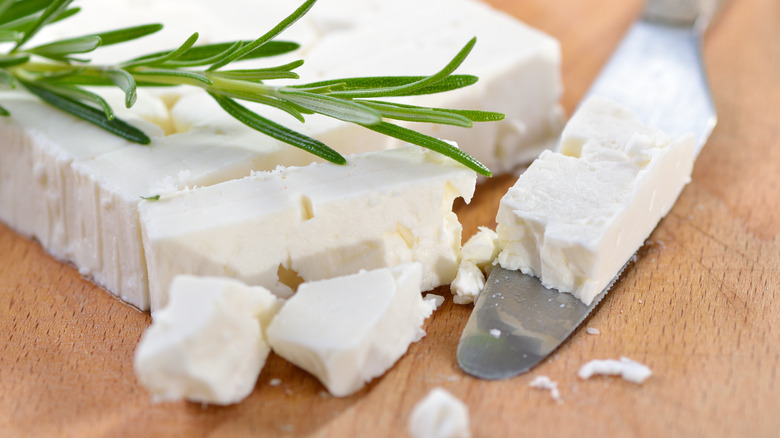Expert Tips For Storing Feta Cheese (And How To Tell If It's Gone Bad)
If you love tangy cheeses, then you're probably already familiar with feta. This cheese has a salty and slightly sour flavor that not only makes it extra yummy, but also makes it ideal for sprucing up salads, sprinkling on baked potatoes (as Ina Garten suggests), or adding some extra zing to a cheesy pizza. If you've picked up some of this cheese from your local supermarket and don't plan to use it all at once, however, proper storage is key. Otherwise, it could go bad before you get to enjoy it.
Kathleen Serino, the training and curriculum manager at New York's famed Murray's Cheese, spoke with The Daily Meal in an exclusive interview to share some suggestions about proper storage for this type of cheese. She explains that "Feta in brine should be treated the same as fresh mozzarella." If you're working with crumbles, on the other hand, those can stay in their original container without any trouble.
For feta packed in brine, keep its liquid levels up
Kathleen Serino shared with The Daily Meal that salty brine is the key to fresh feta. As she explained, "This cheese really does last longer in plenty of brine." That's because the liquid it's packed in helps the cheese retain its moisture, just like mozzarella's brine does.
When we asked Serino what to do when the liquid gets low, she advised, "You could top it off with a bit of filtered water and salt." To do so, just dissolve about 2 teaspoons of kosher salt in 1 to 2 cups of water, depending on how salty you want your cheese to be. Then, completely submerge your feta in the brine before sealing it in an airtight container and popping it in the refrigerator. And remember, as Serino emphasized, "Use a utensil or very clean hands to remove [the cheese] from [the] brine; don't use anything unclean." This tip will help you avoid contamination and extend your feta's shelf life.
Speaking of shelf life, feta has a range; while it may last up to six months, some recommend eating opened feta within a week or two. Serino, however, told us, "You want to eat it sooner rather than later to enjoy its maximum deliciousness." Even if the cheese isn't going bad, per se, you'll still get a tastier snack if you eat it shortly after opening.
Signs your feta has gone bad
If you've purchased feta cheese and suspect it might have gone bad, whether that's due to improper storage or just keeping it around too long, there are a few things to keep an eye out for. If you notice your feta has picked up a funny taste, like if it's overly sour or suddenly has bitter notes, this means that something's not right.
Additionally, noticeable signs of mold growth, such as dark or green discoloration on the cheese, are clues that something is amiss. Your cheese's texture can also indicate that the feta is no longer good. When this cheese spoils, it becomes rubbery and tough and loses its moisture.
If you do notice any of these signs — particularly mold — it's best to throw the cheese out. Mold spores can permeate feta cheese more easily than some other varieties, so even just scraping off a fuzzy or oddly colored section won't fully eradicate the problem. Luckily, with Kathleen Serino's tips, you should be able to avoid these issues from the beginning.


